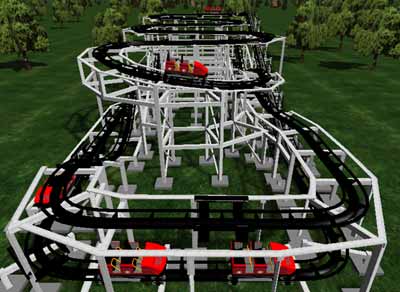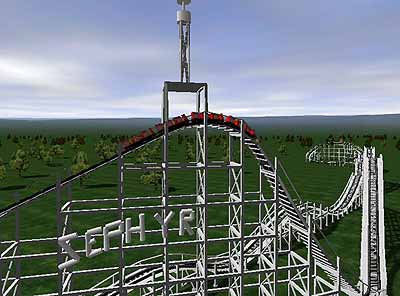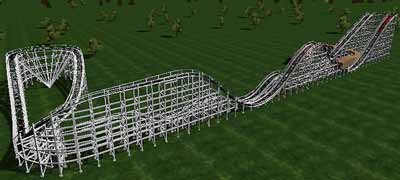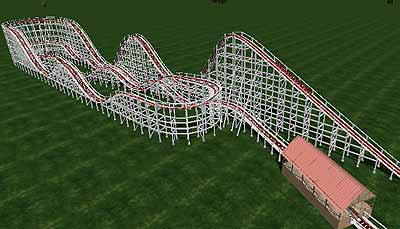The Edgewater Park Thriller
1929 - 1981
Designed By John Miller
This coaster that resided at Detroit Michigan's Edgewater Park has gone by
numerous names. It's been the Thriller, Big Beast, Wild Beast and the Soul Train
during its lifetime. This double out-and-back was designed by John Miller. Part
of the coaster was damaged by fire in the 1950's and rebuilt by National
Amusement Device with some modifications to the trains and track to make it
quieter.
My main source of information about this coaster is Roy Brashears "Rollercoaster
Weekend" video where he had some nice footage of the ride. You can tell by the
state of the coaster and the park in the video that Edgewater park had become
like a lot of Detroit run down in the 1970's and barely made it into the 1980's
before finally closing their doors.
It looks like the Edgewater Thriller might have been a heck of a coaster during
its heyday so give it a ride and let me know what you think.
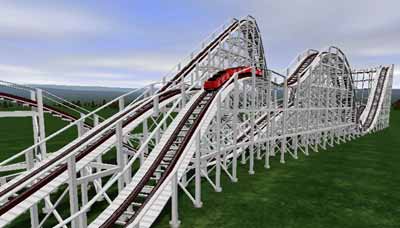
The Ocean View Park Rocket
1929 - 1978
Designed By Herbert Schmeck
The Rocket was a airtime laden seaside coaster that resided in Norfolk Virginia
from 1929 to it's destruction in 1978. Most people know of the Rocket through
the movies though because it played a starring role in the movie "Rollercoaster"
and the "Death Of Ocean View Park". In Rollercoaster a terrorist planted a bomb
on the turn above the station to derail the coaster and in The "Death Of Ocean
View Park" the Rocket was dynamited but refused to fall, the coasters
destruction was eventually brought upon for film by pulling it down with
bulldozers.
I really didn't have any stats on this coaster so most of it so I ended up
guesstimating by a lot of photo interpretation. Give it a ride and let me know
what you think.
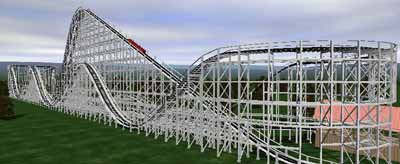
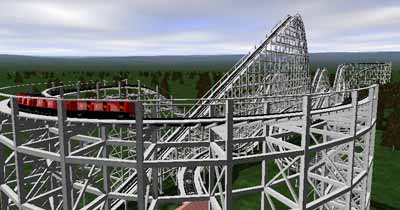
The Whalom Park Flyer Comet
1940 - 2000
Standing But Not Operating 2000 - Present
Designed By Vernon Keenan
Whalom Park closed after their 2000 season and while the Flyer Comet still
stands many of the parks rides have been sold off and the parks ballroom burned
to the ground. There is an ongoing effort by part of the park ownership to save
the park while the other owners want to sell the land off to a developer.
So the Flyer Comet's fate still hangs in the balance.
The Flyer Comet is a copy of a coaster that was at the 1939 New York Worlds Fair
with the only additional change in its design being the addition of the
legendary "Black Hole" tunnel in 1990. It's a fun little twister with some
really good airtime.
I hope the Flyer Comet's story ends on a positive note because I'd really like
to get more than just a virtual ride on it.
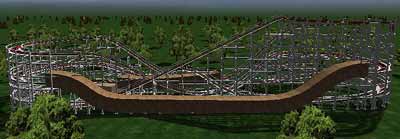
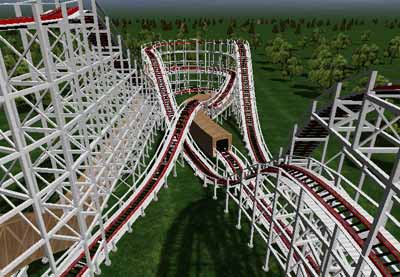
The Idora Park Jack Rabbit
1924 - 1984
Standing But Not Operating 1984 - 2001
Designed By Edward Vettel
When most people who think about Idora Park the first coaster that comes to mind
is the legendary Wildcat. I decided to recreate Idora Park's other coaster the
Jack Rabbit. Built from the remains of the Dip The Dips that was built on the
same plot of land in 1914 the Jack Rabbit was a "L" shaped out and back coaster
that may not have been extreme like the Wildcat but still gave a great ride with
plenty of airtime.
The Jack Rabbit during its last season had trains that faced backwards and was
called the Back Wabbit. This was done because while preparing for the 1984
season the Wildcat accidentally burned to the ground and the park needed
something to get people to visit. Unfortunately the Jack Rabbit wasn't enough of
a draw and the park closed that season.
If you're interested in seeing what Idora Park and the Jack Rabbit looked like
during their final years
click here.
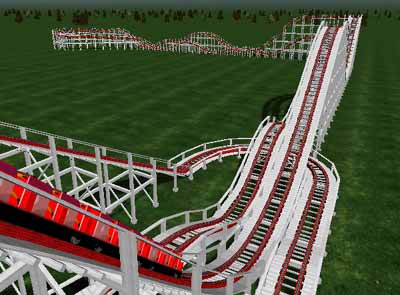
The Coney Island Thunderbolt
1925-1983
Standing But Not Operating 1983-2000
Designed By John Miller
The Thunderbolt sat rotting along Coney
Island's famous boardwalk from 1983 through 2000 when it was suddenly
demolished. Before it's death the Thunderbolt thrilled riders for fifty-eight
years. It became famous starring in several movies most notably "Annie Hall"
which some of the scenes took place in the house that sat under the
Thunderbolt's first turnaround.
As with most coasters at Coney Island, the Cyclone being the only surviving one
and most famous, the Thunderbolt had to give the most thrills while using the
least space. So expect a few close calls and head choppers along with an air
filled ride.

The Chippewa Lake Park Big Dipper
1925 - 1978
Designed By Fred W. Pearce & Josiah Pearce
I was first introduced to the Big Dipper or Coaster (I have heard it referred to
both names) while looking through a web site about defunct parks. Chippewa Lake
opened in 1878 and closed a century later. It was primary a picnic park located
on Ohio's largest natural lake. In the 1970's picnics declined and a rough crowd
started to hang out at Chippewa Lake Park causing the park to close after the
1978 season.
In 2002 I had the privilege of visiting the remains of Chippewa Lake Park where
the coaster still stands slowly rotting away and being swallowed up by the
forest. If you're interested in what the Big Dipper looks like today
click here.
The Big Dipper was a junior sized woody that was meant to be a fun ride for the
whole family. It starts with a nice long tunnel to the lift and has several
moments of airtime for everyone to enjoy.
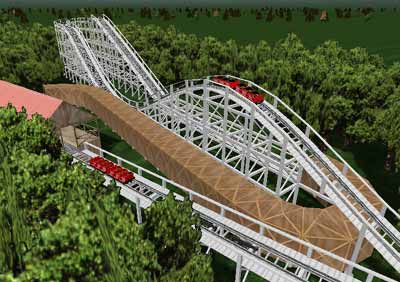
The Puritas Springs Cyclone
1928 - 1958
Designed by John Miller
Known as one of the ultimate ravine coasters due to it's location next to and
through a deep ravine the Puritas Springs Cyclone was one of the most terrifying
coasters of the "Golden Era" of roller coasters. The Cyclone featured several
drops into a deep and heavily wooded ravine and a turnaround that sat on top of
a 500 foot cliff. There was at least one death on the Cyclone and the park
closed it for a short while before reopening. A fire at Puritas Springs Park
forced them to close doors in 1958 and all that remains is a housing development
and the last drop of the cyclone which still sits down in the ravine.
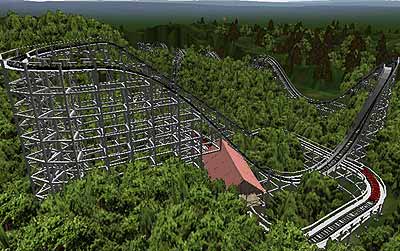
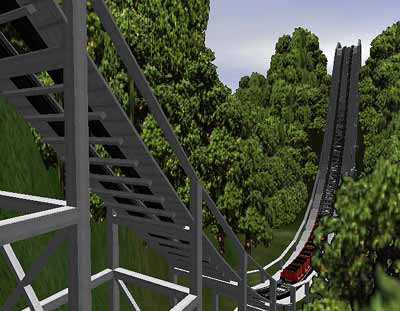
The Port Arthur Pleasure Pier Comet
1942 - 1958
Designed By Herbert Schmeck
Designed by Herbert Schmeck of the Philadelphia Toboggan Company this coaster
lasted from 1942 to 1958. It closed in 1958 after being damaged by a hurricane.
I found a picture of it on Ebay and saved the image. After studying it for a
while I finally decided to make a copy of it to ride. It's a fun little
air-filled coaster that would fit perfectly at a nice traditional park today.
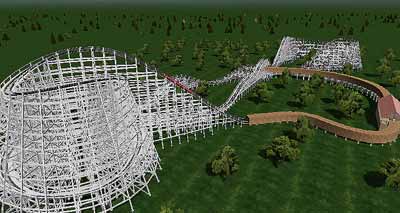
The Mountain Flyer
1929 - 1987
Designed By Herbert Schmeck
The Mountain Flyer operated at Mountain Park
from 1929 until 1987. It's basically an out and back with a little dog
leg.
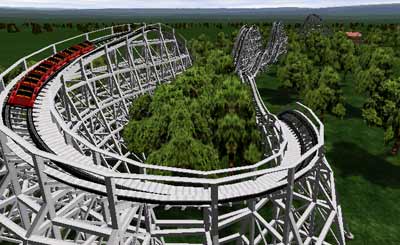
The Cannonball
1915 - 1925
Designed By John Miller
The Cannonball was a very short lived
coaster at Chicago's Riverview Park. As you can see by the picture it's
basically an airtime machine and would be a nice small coaster at any park.
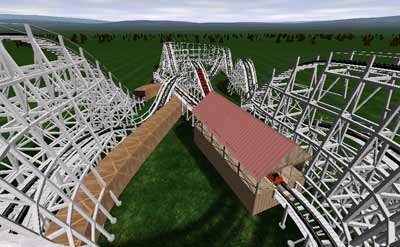
The Riverview Bobs
1924 - 1967
Designed By Frank Pryor & Frederick Church
The Bobs have been called the Ultimate
Coaster. This is not a coaster for the weak or timid. Part of the
reason I'm an enthusiast is from hearing all my older relatives talk about the
Bobs. Unfortunately all that's left of the Bobs are a few footers and a
shopping center. I hate progress...especially when a park with 8 wooden
coasters has to go. T took the layout from photos and blueprints that are
in the book "Laugh Your Troubles Away" but I had to raise the lift height as
those blueprints say the lift was 56 feet tall and it barely made it around the
track. In the book "Harry G. Traver: Legends of Terror" they report
the Bob's height as 87 so that's what I went with.
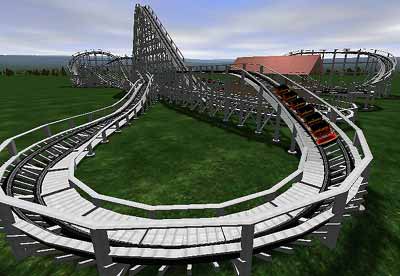
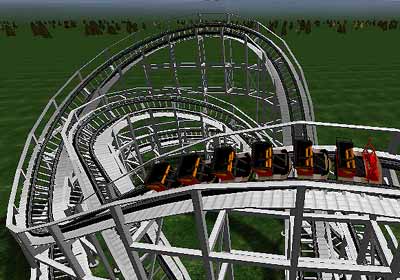
Click here
for more No Limits Rollercoaster downloads.
-G Home
-G Forums

